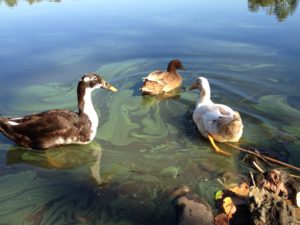Taste and Odor Season is Upon Us
Occasionally our customers notice a musty, “green”, or earthy taste or odor to our water. What causes this, and is it safe to drink?
Yes. The taste and odor is a palatability issue. The palatability change that results from a naturally occurring algal bloom or organic matter event does not alter the quality of the water provided to CRW customers. The water supply remains safe to drink, meeting or exceeding all regulatory requirements.
Well, it’s that time of year again! Every summer when the weather gets hot and sunny, the river gets low, and the water warms up we start to see ideal conditions for an algae to grow. It’s taste and odor season.
Our water source is a natural system, which means that our drinking water is subject to the natural changes and fluctuations of the environment that can alter the taste of our water.
What causes taste and odor in drinking water?
In the Clackamas River there are two primary sources of taste and odor events:
Organic Matter
Organic matter is typically responsible for an “earthy” taste. In the winter and spring organic matter is most often the primary cause of taste or odor events in CRW’s drinking water.
In the spring and fall the amount of organic matter, such as leaves or other vegetation, typically increases due to seasonal changes. Melting snow and hard rains can wash the organic matter on the ground into the river and streams. In the Fall, usually concurrent with the first fall storm, high river flows can scrape the river bottom and stir up debris that has been below the surface of the water for many months. These materials that have been washed into or scraped off the bottom of the rivers will combine with the chemicals added during water processing to cause the noticeable changes in tastes and odors that periodically occur.
Algae
Algae are typically responsible for a fishy, earthy, “green”, or cucumber-like taste in the water. Algae blooms are natural events that occur in many surface water systems. Algae events are the most common cause of taste and odor events in CRW’s drinking water from mid-summer through early fall. However, algae blooms can occur at any time when the conditions are favorable for algal growth (warm temperatures, sunlight, nutrients, etc).
Algae blooms are common in the North Fork Reservoir upstream of the CRW intakes in late summer and early fall. CRW, through the Clackamas River Water Providers (CRWP), tests for any potential toxins at the first sight of an algal bloom. Toxins are rarely detected in the source water of the Clackamas River and have not be detected in CRWP treated drinking water.
What steps does the CRW take to control the taste and odor?
Taste and odor events caused by organic matter are difficult to control. Currently CRW is looking towards the future, evaluating treatment process changes that can remove more organic matter before it can interact with disinfection processes.
For taste and odor events caused by algae, additional chemicals are often added to the treatment process to aid in the reduction of taste and odors once the onset of a bloom is confirmed. To reduce unpleasant taste caused by the algal bloom, activated carbon is used as an absorption media. Unfortunately activate carbon cannot entirely eliminate unpleasant tastes and odors.
CRW believes that the best defense for taste and odor events caused by algae is proactive sampling and monitoring to anticipate bloom events and begin treatment alterations before problems occur. The CRW Water Quality Department conducts weekly in-house algae counts and identification in the Clackamas River Watershed and at the intakes of the CRW treatment plant to better understand algal bloom dynamics.






